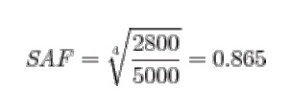The McMansion Penalty in ENERGY STAR Version 3

 When I first became a HERS rater and went to the RESNET conference in 2004, I got to talk with David Lee, who was the head of the ENERGY STAR homes program at the time. Because I was puzzled by the paradox large homes with energy efficiency certifications, I asked him, How can a 15 thousand square foot house even be considered for the ENERGY STAR program? I’ve long been bothered by the focus on energy efficiency at the expense of energy conservation.
When I first became a HERS rater and went to the RESNET conference in 2004, I got to talk with David Lee, who was the head of the ENERGY STAR homes program at the time. Because I was puzzled by the paradox large homes with energy efficiency certifications, I asked him, How can a 15 thousand square foot house even be considered for the ENERGY STAR program? I’ve long been bothered by the focus on energy efficiency at the expense of energy conservation.
When I first became a HERS rater and went to the RESNET conference in 2004, I got to talk with David Lee, who was the head of the ENERGY STAR homes program at the time. Because I was puzzled by the paradox large homes with energy efficiency certifications, I asked him, How can a 15 thousand square foot house even be considered for the ENERGY STAR program? I’ve long been bothered by the focus on energy efficiency at the expense of energy conservation.
The standard answer that Mr. Lee and others have given to my question is that large homes are going to be built anyway, and allowing them to qualify for the ENERGY STAR label ends up helping them use less energy than they would otherwise. Yeah, that may be true, but it still bothered me that large homes didn’t even have to do anything extra to make up for all the extra kilowatt-hours they used just because of the extra size.
Now, in Version 3 of the ENERGY STAR new homes program, that changes. If you’ve read any of my other ENERGY STAR articles here in the blog, you may remember that large houses get penalized in the program starting with Version 2.5 (which is in effect for all houses permitted as of 1 April 2011 and finished before 1 January 2012).
The threshold for determining whether a home gets penalized or not is whether its conditioned floor area is greater than the floor area of what ENERGY STAR calls the Benchmark Home. As you can see in the table below, many new homes will be penalized. For example, any 3 bedroom home that has more than 2200 square feet of conditioned floor area has to pay the large home penalty.

The way this gets implemented is through the Size Adjustment Factor, a number less than 1 for homes larger than the Benchmark Home and equal to 1 otherwise. If a home that’s going for the ENERGY STAR label is larger than the Benchmark Home, the HERS Index target gets multiplied by the Size Adjustment Factor. The equation to calculate the Size Adjustment Factor is:

For example, a 4 bedroom that has 5000 square feet of conditioned floor area would have a Size Adjustment Factor of:

If the HERS Index of the ENERGY STAR Reference Design is, say, 70, the HERS Index target for the rated home would be 70 x 0.865 = 61. What this means is that if the rated home were 2800 square feet or less, it would need a HERS Index of 70 to qualify. Because the home is larger, however, it needs to get an Index of 61, or about 13% more efficient than the smaller home.
This is good! I like the large home penalty because now ENERGY STAR is acknowledging that not only is the kilowatt-hour per square foot energy efficiency of a house important, but so is the total number of kilowatt-hours that result from the extra square feet in large houses.
If you’re a HERS rater, you can get the scoop on all the changes by taking one of our ENERGY STAR Version 3 classes. Click the button below to find out more and check our class schedule.
Photo of Gilbert Mansion by andrew_j_w from Flickr.com, used under Creative Commons license.
This Post Has 7 Comments
Comments are closed.


Now we need a factor/penalty
Now we need a factor/penalty for the your “second” home. Wait, I have to be careful, most of the homes I build are second homes…..
Good one, Stephen! I think
Good one, Stephen! I think the way to get at the issue of second homes, though, is to have an ENERGY STAR program for people. In it, anyone who owns a second home would have to show some kind of energy offsets, as in a cap-and-trade program.
Although Energy Star version
Although Energy Star version 3 has improved some of the energy efficiency measures including the size factoring, it has also drifted from the core brand message of Energy Efficiency and developed a high cost program that measures water efficiency, comfort, etc… In Wisconsin, the program is nearly non-existent due to the changes. Version 2 was reasonably supported, but version 3 won’t be. If we are really after energy efficiency, can’t we just simply measure heating and cooling intensity (e.g. btu/ft2/hdd and btu/ft2/cdd)and call it a day?
Steve, on the one hand, I’ve
Steve, on the one hand, I’ve been thinking the same thing lately. All of the green building and energy efficiency programs are getting so complicated that it’d be great to have a measure that’s simple like energy intensity, whether heating, cooling, or total. I’ve long used a spread sheet to calculate the total kWh/ft2, and it’s such a good measure of how a home performs. I understand the motivation behind all the prescriptive requirements, but it just seems sometimes like we’ve lost sight of what we’re really after.
On the other hand, the focus on the individual requirements has resulted in a lot more people being trained in the details, and, as we all know, that’s where the devil is. I do think something’s gotta give, though.
One note about ES V3: It does NOT include water efficiency. That was in the draft version but got taken out after the first review period.
Well, at least there’s a
Well, at least there’s a quartic root in this article. I am still hoping to one day see triple integrals on this blog, but this will suffice for now! 😛
John: Nice
John: Nice to see someone here who appreciates math! I’ll get to work on that post with triple integration. What coordinate system would you like? Spherical? Cylindrical? Bipolar? And how about some partial differential equations in three dimensions, with spherical harmonics or Bessel functions as the solution?
Allison, all that stuff is
Allison, all that stuff is fine. Include whatever you want. But what I now think I’d really like to see is a flex duct in the shape of a Klein Bottle! Oh, wait a minute…you’ve already posted a picture of that in your most recent article. Never mind! 😀